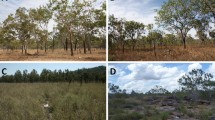Abstract
The ecological role of ants in tropical annual cropping systems is discussed in general and with respect to a specific Mexican agroecosystem Generally, the potential positive contributions of ants to crop yields result from their impact on soil structure, nutrient cycling, and reduction of insect and weed pests
In annual wet lowland fields in eastern Mexico, the ant community is simple and dominated by the aggressive fire ant,Solenopsis geminata. The influence of vegetation structure and composition on the ant community and, specifically, on the foraging behavior ofS geminata is discussed
Similar content being viewed by others
Literature cited
Anonymous. 1965. Studi ed esperienze pratiche di protezione biologica. Min. Agr. For., Roma, Collana Verde 16. 414 pp.
Auclair, J. L. 1963. Aphid feeding and nutrition.Ann. Rev. Entomol. 8:439–490.
Bentley, B. 1976. Plants bearing extrafloral nectaries and the associated ant community: interhabitat differences in the reduction of herbivore damage.Ecology 57:815–820.
—. 1977. The protective function of ants visiting the extrafloral nectaries ofBixa orellana (Bixaceae).J. Ecol. 65:27–38
Brian, M. V. 1965. Social insect populations. Academic Press, New York, NY. 135 pp.
Carroll, C. R. 1974. The community ecology of tropical arboreal ants. Ph.D. Dissertation. University of Chicago, Chicago, IL. 196 pp.
—. 1978. Beetles, parasitoids and tropical morning glories: a study in host discrimination.Ecol. Entomol. 3:79.
Carroll, C. R., and D. H. Janzen. 1973. Ecology of foraging by ants.Ann. Rev. Ecol. Syst. 4:231–251.
Carroll, C. R., and S. J. Risch. In review. The dynamics of seed harvesting in early successional communities by a tropical ant,Solenopsis geminata. Ecol.
Eisner, T. 1957. A comparative morphological study of the proventriculus of ants (Hymenoptera: Formicidae).Bull. Mus. Comp. Zool., Harvard. 116:439–490.
Eisner, T., and E. M. Happ. 1962. The infrabuccal pocket of a formicine ant: a social filtration device.Psyche 69:107–116.
Entwistle, P. F. 1972. Pests of cocoa. Longman, London. 799 pp.
Freeland, J. 1958. Biological and social patterns in the Australian bulldog ants of the genusMyrmecia.Aust. J. Zool. 6:1–18.
Janzen, D. H. 1967. Interaction of the bull's-horn acacia (Acacia Cornigera L.) with an ant inhabitant (pseudomyrmex ferruginea F. Smith) in Eastern Mexico.Univ. Kans. Sci. Bull. 47:315–558.
Kranz, J., H. Schmutterer, and W. Koch, 1977. Diseases, pests and weeds in tropical crops. Verlag Parey. 666 pp.
LeMasne, G. 1953. Observations sur les relations entre le couvain et les adultes chez les fourmis.Ann. Sci. Nat. 15:1–56.
Leston, D. 1973. The ant mosaic—tropical tree crops and the limiting of pests and diseases.PANS 19:311–341.
—. 1978. A neotropical ant mosaic.Ann. Entomol. Soc. Amer. 71:649–653.
Lofgren, C. S., W. A. Banks, and B. N. Glancey. 1975. Biology and control of imported fire ants.Ann. Rev. Entomol. 20:1–29.
Markin, G. P. 1970. Food distribution within laboratory colonies of the Argentine ant,Iridomyrmex humilis (Mayr).Insects Soc. 17:127–158.
McIlveen, W. D., and H. Cole. 1976. Spore dispersal of Endogonaceae by worms, ants, and birds.Can. J. Bot. 54:1486–1489.
Naarman, H. 1963. Untersuchungen über Bildung und Weitergabe von Drusensekreten beiFormica (Hymenoptera: Formicidae) mit Gilfe der Radioisotopenmethode,Experientia 19:412, 413.
Oster, G. F., and E. O. Wilson. 1978. 12. Caste and ecology in the social insects. Monographs in population biology. Princeton University Press, Princeton, NJ. 352 pp.
Risch, S. J. 1980. Ants as important predators or rootworm eggs in the neotropics.J. Econ. Entomol. 74:88–90.
Risch, S. J., and C. R. Carroll. 1982a. The ecological role of ants in two Mexican agroecosystems. Oecologia (in press).
—. 1982b. Effect of a keystone predaceous ant,Solenopsis geminata, in a nonequilibrium community.Ecology. (In press).
Room, P. M. 1975. Relative distributions of ant species in cocoa plantations in Papua New Guinea.J. Appl. Ecol. 12:47–62.
Saks, M. E., and C. R. Carroll. 1980. Ant foraging activity in tropical agro-ecosystems.Agro-Ecosystems 6:177–188.
Vello, F. 1971. Observances sobre polinacao la cacaueiro na Bahia. Pages 565–575in Proceedings of the 3rd Int. Cocoa Res. Conf. Accra.
Way, M. J. 1954. Studies on the association of the antOccophylla longinoda with the scale insectSaissetia zanzibarensis Williams.Bull. Entomol. Res. 45:113–134.
Way, M. J. 1963. Mutualism between ants and honeydew producing Homoptera.Ann. Rev. Entomol. 8:307–344.
Weber, N. 1972. Gardening ants: the attines.Am. Phil. Soc. Phil. Mem. Vol. 92. 146 pp.
Wheeler, W. M. 1910. Ants—their structure, development and behavior. Columbia University Press, New York, NY. 663 pp.
Whitcomb, W. H., H. A. Denmark, A. P. Bhatkar, and G. L. Greene. 1972. Preliminary studies on the ants of Florida soybean fields.Fla. Entomol. 55:129–142.
Wilson, E. O. 1971. The insect societies. Belknap Press, Cambridge. 548 pp.
Wilson, E. O. 1978. Division of labor in fire ants based on physical castes (Hymenoptera: Formicidae: Sopenopsis).J. Kansas Entomol. Soc. 51:615–636.
Author information
Authors and Affiliations
Rights and permissions
About this article
Cite this article
Carroll, C.R., Risch, S.J. Tropical annual cropping systems: Ant ecology. Environmental Management 7, 51–57 (1983). https://doi.org/10.1007/BF01867041
Issue Date:
DOI: https://doi.org/10.1007/BF01867041




